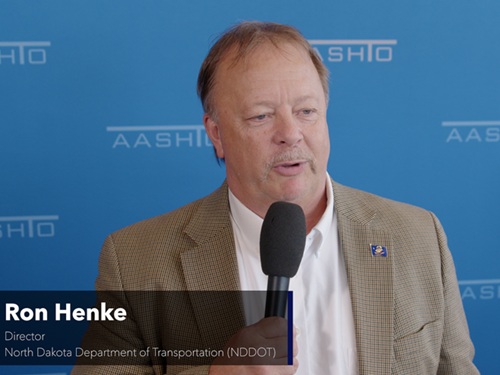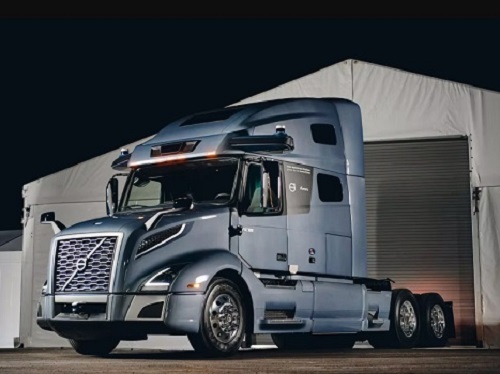In early June, Volvo Autonomous Solutions or VAS – a division of Sweden’s Volvo Group – opened an office in Fort Worth, TX, as it prepares to offer dedicated self-driving truck service along the first autonomous freight corridors in the United States; corridors linking the Texas cities of Dallas/Fort Worth and El Paso as well as Dallas/Fort Worth and Houston.
[Above photo by Volvo]
To prepare for the commercial launch of its autonomous truck service, VAS has started hauling loads “manually” – meaning via trucks piloted by human drivers – for customers such as DHL and Uber Freight to test aspects of its autonomous transport solution; establishing frameworks and procedures for safe and reliable operations.
“We believe the path to autonomy at scale is through reducing the friction and complications around ownership and operations for customers. This is why we have taken the decision to be the single interface to our customers and take full ownership of the elements required for commercial autonomous transport,” explained Nils Jaeger, president of VAS, in a statement.
“With the opening of our office in Texas and start of operational activities, we are building the foundations for a transport solution that will change the way we move goods on highways,” he pointed out.
“Through our Autonomous Transport Solution (ATS), our ambition is to create a new source of industry capacity that will ease some of the burden of the increasing demand for freight while also enabling local drivers to shift into short-haul jobs that will keep them closer to home,” added Sasko Cuklev, head of on-road solutions for VAS. “This will unlock significant efficiencies in the entire supply chain and benefit everyone in the transportation industry.”
He noted that the ATS offered by VAS includes hardware, software and services required to run autonomous transport operations. On highways, it operates based on a “hub-to-hub” model where autonomous trucks take on the highway portion of the driving, operating all hours of the day and night between transfer hubs while human drivers complete local operations.
The ATS technology package is based on a system provided by Aurora called “Aurora Driver” that is integrated with Volvo’s on-highway truck models. The ATS package is also based around what’s been dubbed a “Transport as a Service” or TaaS model and includes a vehicle purpose-built for autonomous driving, a virtual driver, required infrastructure, operations and uptime support as well as a cloud solution that controls the transport system and manages logistics flows.
State departments of transportation across the country and deeply involved in a variety of similar automated vehicle test programs, in both freight and passenger operations.
For example, automated vehicles began operating on rural roadways in central and southeast Ohio in January as part of the Rural Automated Driving Systems or RADS project spearheaded by DriveOhio, a division of the Ohio Department of Transportation.
Funded in part by a $7.5 million grant from the U.S. Department of Transportation, this project aims to demonstrate how connected and automated semi-trucks and passenger vehicles could improve safety for drivers, passengers, and other travelers in rural settings.
[Editor’s note: In October 2021, the American Association of State Highway and Transportation Officials published a policy paper outlining the 10 key policy principles needed for connected and automated vehicles or CAVs – a paper intended to be a “living document,” reviewed and updated every year to reflect changes in technology and policy. To access that paper, click here.]
Meanwhile, the Pennsylvania Department of Transportation participated in autonomous transit vehicle testing in Philadelphia, along with researchers from Drexel University and consulting firm AECOM.
That testing involves a mid-size electric autonomous shuttle bus shutting passengers from the Philadelphia Navy Yard to the Southeastern Pennsylvania Transportation Authority’s NRG Station back in the spring of 2023.
Also, in August 2022, the Minnesota Department of Transportation helped launch a free, low-speed, driverless, all-electric, multi-passenger shuttle service called “Bear Tracks” for the city of White Bear Lake.
And in March 2022, the North Dakota Department of Transportation issued funds to support a range of autonomous systems research aimed at helping the agency develop and maintain the state’s transportation system.
Additionally, the Virginia Department of Transportation helped vehicle maker Audi of America test a cellular vehicle-to-everything or C-V2X system over a two-year period that incorporated autonomous operations as well as other safety innovations.
 Nation
Nation
North Dakota DOT Profiled in State DOT Update
July 3, 2025 Nation
Nation

